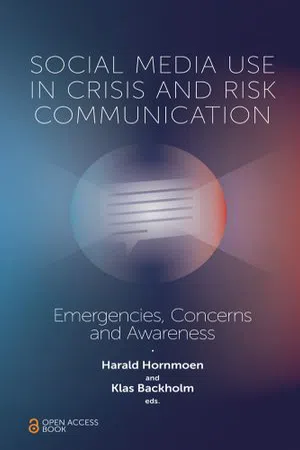
Social Media Use In Crisis and Risk Communication : Emergencies, Concerns and Awareness
- English
- PDF
- Available on iOS & Android
Social Media Use In Crisis and Risk Communication : Emergencies, Concerns and Awareness
About This Book
Crises pose an immediate risk to life, health, and the environment and require urgent action. The public's use of social media has important implications for contingency policies and practices. Social media have the potential for risk reduction and preventive interaction with the public. This book is about how different communicators - whether crisis managers, first responders, journalists, or private citizens and disaster victims - have used social media to communicate about risks and crises. It is also about how these very different actors can play a crucial role in mitigating or preventing crises. How can they use social media to strengthen their own and the public's awareness and understanding of crises when they unfold? How can they use social media to promote resilience during crises and the ability to deal with the after-effects? Chapters address such questions by presenting new research-based knowledge on social media use during different crises: the terrorist attacks in Norway on 22 July 2011; the central European floods in Austria in 2013; and the West African Ebola-outbreak in 2014. The collection also presents research on the development of a tool for gathering social media information, based on a user-centered design. Social Media use in Crisis and Risk Communication presents cutting-edge research on the use of social media in crisis communication and reporting. It gives recommendations about how different crisis communicators (information officers, crisis managers, journalists) can improve their ability to gather information, communicate and raise people's crisis awareness by using social media.
Frequently asked questions
Information
Table of contents
- Front Cover
- Social Media Use in Crisis and Risk Communication: Emergencies, Concerns and Awareness
- Copyright Page
- Acknowledgements
- Contents
- About the Editors
- About the Contributors
- Social Media Use in Crises and Risks: An Introduction to the Collection
- Part 1. Using Social Media in Risks and Crises
- Part 2. Developing a Tool for Crisis Communicators
- Part 3. Recommendations for Social Media Use in Risks and Crises
- Index